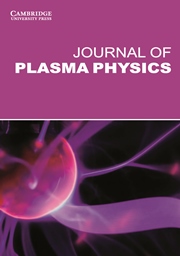Article contents
Time-dependent non-planar dust-acoustic solitary and shock waves in strongly coupled adiabatic dusty plasma
Published online by Cambridge University Press: 23 October 2012
Abstract
Time-dependent cylindrical and spherical dust-acoustic (DA) solitary and shock waves propagating in a strongly coupled dusty plasmas (containing strongly correlated negatively charged dust grains and weakly correlated adiabatic electrons and ions) are investigated. It is shown that cylindrical and spherical DA solitary and shock waves exist with negative potential, and that the strong correlation between the charged dust grains is a source of dissipation, and is responsible for the formation of cylindrical or spherical DA shock structures. It is also shown that the effects of a non-planar geometry (cylindrical and spherical) significantly modify the basic features (e.g. amplitude, width, speed, etc.) of DA solitary and shock waves. The implications of our results in laboratory experiments are briefly discussed.
Information
- Type
- Papers
- Information
- Copyright
- Copyright © Cambridge University Press 2012
References
- 5
- Cited by

